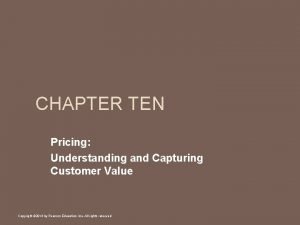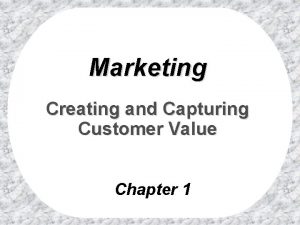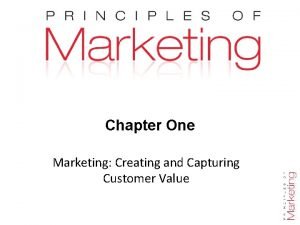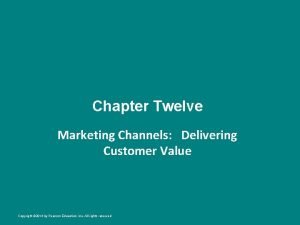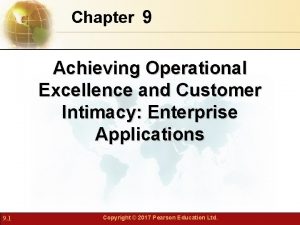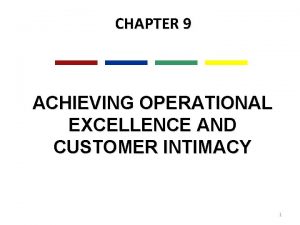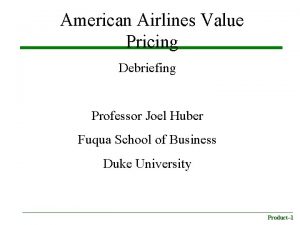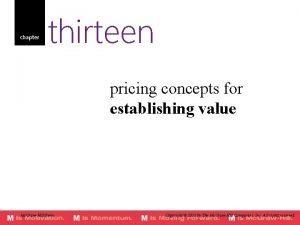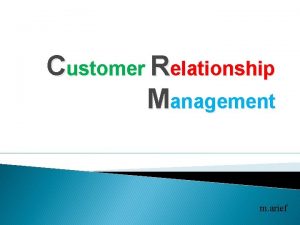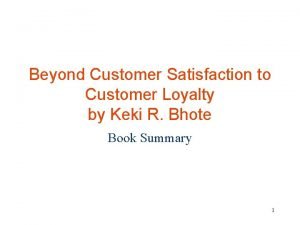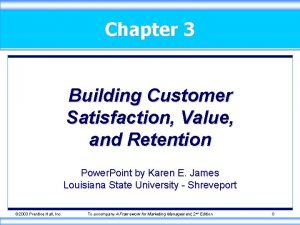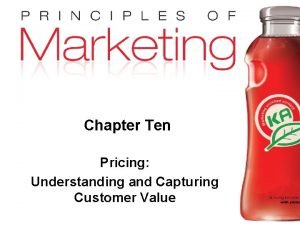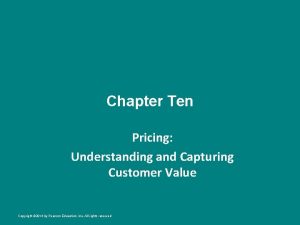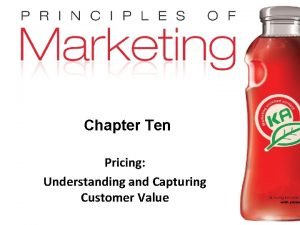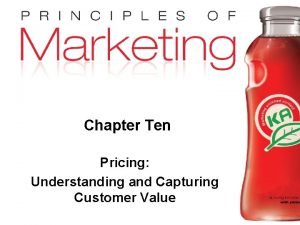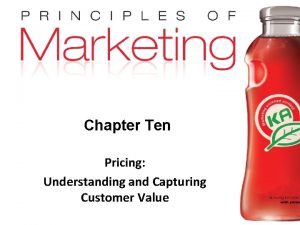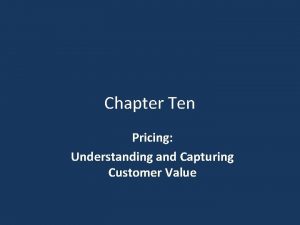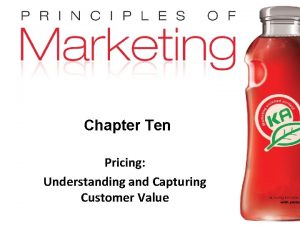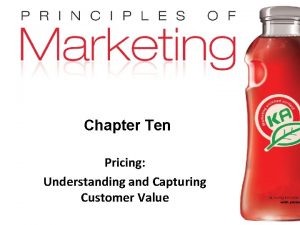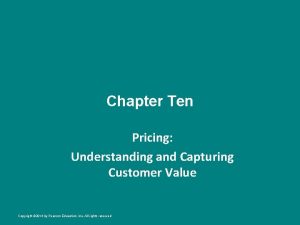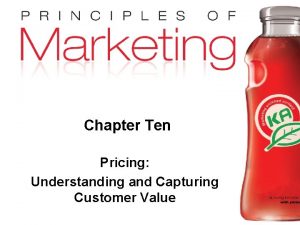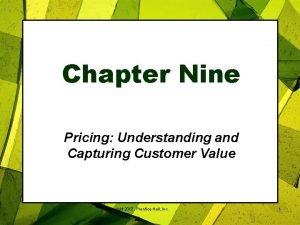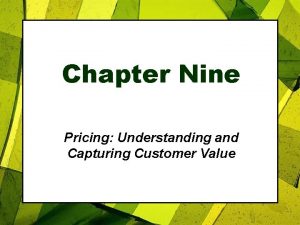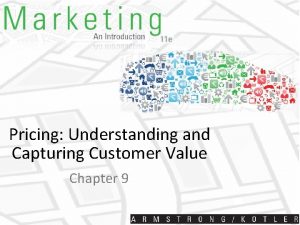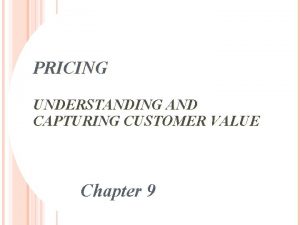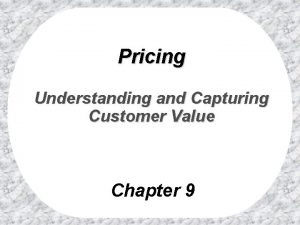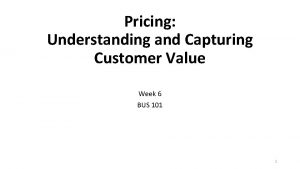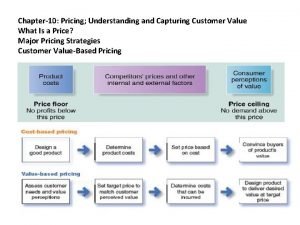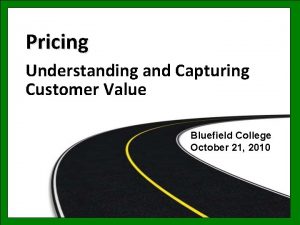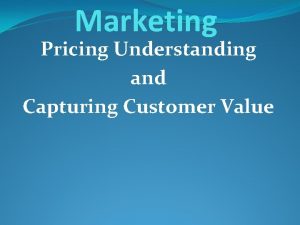Chapter Ten Pricing Understanding and Capturing Customer Value























- Slides: 23

Chapter Ten Pricing: Understanding and Capturing Customer Value Copyright © 2009 Pearson Education, Inc. Publishing as Prentice Hall Chapter 10 - slide

Pricing: Understanding and Capturing Customer Value Topic Outline • What Is a Price? • Customer Perceptions of Value • Company and Product Costs • Other Internal and External Considerations Affecting Price Decisions Copyright © 2010 Pearson Education, Inc. Publishing as Prentice Hall Chapter 10 - slide 2

What Is a Price? Price is the amount of money charged for a product or service. It is the sum of all the values that consumers give up in order to gain the benefits of having or using a product or service. Copyright © 2010 Pearson Education, Inc. Publishing as Prentice Hall Chapter 10 - slide 3

Factors to Consider When Setting Prices Customer Perceptions of Value Understanding how much value consumers place on the benefits they receive from the product and setting a price that captures that value Copyright © 2010 Pearson Education, Inc. Publishing as Prentice Hall Chapter 10 - slide 4

Factors to Consider When Setting Prices Customer Perceptions of Value Copyright © 2010 Pearson Education, Inc. Publishing as Prentice Hall Chapter 10 - slide 5

Factors to Consider When Setting Prices Customer Perceptions of Value-based pricing uses the buyers’ perceptions of value, not the sellers cost, as the key to pricing. Price is considered before the marketing program is set. • Value-based pricing is customer driven • Cost-based pricing is product driven Copyright © 2010 Pearson Education, Inc. Publishing as Prentice Hall Chapter 10 - slide 6

Factors to Consider When Setting Prices Customer Perceptions of Value Copyright © 2010 Pearson Education, Inc. Publishing as Prentice Hall Chapter 10 - slide 7

Factors to Consider When Setting Prices Customer Perceptions of Value-based pricing Good-value pricing Value-added pricing Copyright © 2010 Pearson Education, Inc. Publishing as Prentice Hall Chapter 10 - slide 8

Factors to Consider When Setting Prices Customer Perceptions of Value Good-value pricing offers the right combination of quality and good service to fair price Existing brands are being redesigned to offer more quality for a given price or the same quality for less price Copyright © 2010 Pearson Education, Inc. Publishing as Prentice Hall Chapter 10 - slide 9

Factors to Consider When Setting Prices Customer Perceptions of Value Everyday low pricing (EDLP) involves charging a constant everyday low price with few or no temporary price discounts High-low pricing involves charging higher prices on an everyday basis but running frequent promotions to lower prices temporarily on selected items Copyright © 2010 Pearson Education, Inc. Publishing as Prentice Hall Chapter 10 - slide 10

Factors to Consider When Setting Prices Customer Perceptions of Value • Value-added pricing attaches value-added features and services to differentiate offers, support higher prices, and build pricing power • Pricing power is the ability to escape price competition and to justify higher prices and margins without losing market share Copyright © 2010 Pearson Education, Inc. Publishing as Prentice Hall Chapter 10 - slide 11

Factors to Consider When Setting Prices Company and Product Costs Cost-based pricing involves setting prices based on the costs for producing, distributing, and selling the product plus a fair rate of return for its effort and risk Copyright © 2010 Pearson Education, Inc. Publishing as Prentice Hall Chapter 10 - slide 12

Factors to Consider When Setting Prices Company and Product Costs Cost-based pricing adds a standard markup to the cost of the product Copyright © 2010 Pearson Education, Inc. Publishing as Prentice Hall Chapter 10 - slide 13

Factors to Consider When Setting Prices Company and Product Costs Types of costs Fixed costs Variable costs Copyright © 2010 Pearson Education, Inc. Publishing as Prentice Hall Total costs Chapter 10 - slide 14

Factors to Consider When Setting Prices Company and Product Costs Fixed costs are the costs that do not vary with production or sales level • Rent • Heat • Interest • Executive salaries Copyright © 2010 Pearson Education, Inc. Publishing as Prentice Hall Chapter 10 - slide 15

Factors to Consider When Setting Prices Company and Product Costs Variable costs are the costs that vary with the level of production • Packaging • Raw materials Copyright © 2010 Pearson Education, Inc. Publishing as Prentice Hall Chapter 10 - slide 16

Factors to Consider When Setting Prices Company and Product Costs Total costs are the sum of the fixed and variable costs for any given level of production Average cost is the cost associated with a given level of output Copyright © 2010 Pearson Education, Inc. Publishing as Prentice Hall Chapter 10 - slide 17

Factors to Consider When Setting Prices Costs at Different Levels of Production Copyright © 2010 Pearson Education, Inc. Publishing as Prentice Hall Chapter 10 - slide 18

Factors to Consider When Setting Prices Costs as a Function of Production Experience or learning curve is when average cost falls as production increases because fixed costs are spread over more units Copyright © 2010 Pearson Education, Inc. Publishing as Prentice Hall Chapter 10 - slide 19

Factors to Consider When Setting Prices Cost-Plus Pricing • Cost-plus pricing adds a standard markup to the cost of the product • Benefits – Sellers are certain about costs – Prices are similar in industry and price competition is minimized – Consumers feel it is fair • Disadvantages – Ignores demand competitor prices Copyright © 2010 Pearson Education, Inc. Publishing as Prentice Hall Chapter 10 - slide 20

Factors to Consider When Setting Prices Break-Even Analysis and Target Profit Pricing Break-even pricing is the price at which total costs are equal to total revenue and there is no profit Target profit pricing is the price at which the firm will break even or make the profit it’s seeking Copyright © 2010 Pearson Education, Inc. Publishing as Prentice Hall Chapter 10 - slide 21

Factors to Consider When Setting Prices Break-Even Analysis and Target Profit Pricing Copyright © 2010 Pearson Education, Inc. Publishing as Prentice Hall Chapter 10 - slide 22

Considerations in Setting Price Copyright © 2010 Pearson Education, Inc. Publishing as Prentice Hall Chapter 10 - slide 23
 Pricing: understanding and capturing customer value
Pricing: understanding and capturing customer value Creating and capturing customer value
Creating and capturing customer value Creating and capturing customer value
Creating and capturing customer value A simple model of the marketing process
A simple model of the marketing process Value creation vs value capture
Value creation vs value capture Qualitative research techniques to measure brand equity
Qualitative research techniques to measure brand equity Capturing customer mindset
Capturing customer mindset Contoh value creation adalah
Contoh value creation adalah Ten twenty thirty forty
Ten twenty thirty forty Ten ten siempre fuerzas y esperanza
Ten ten siempre fuerzas y esperanza Ten ten program
Ten ten program Marketing channels: delivering customer value
Marketing channels: delivering customer value Customer relationship management and customer intimacy
Customer relationship management and customer intimacy Customer relationship management and customer intimacy
Customer relationship management and customer intimacy Customer relationship management and customer intimacy
Customer relationship management and customer intimacy Building customer satisfaction
Building customer satisfaction American airlines value pricing
American airlines value pricing Pricing concepts for establishing value
Pricing concepts for establishing value Despite the data glut that marketing managers
Despite the data glut that marketing managers Pengertian customer relationship
Pengertian customer relationship Beyond customer satisfaction to customer loyalty
Beyond customer satisfaction to customer loyalty Creating customer relationships and value through marketing
Creating customer relationships and value through marketing Products services and brands building customer value
Products services and brands building customer value How to build customer satisfaction value and retention
How to build customer satisfaction value and retention
